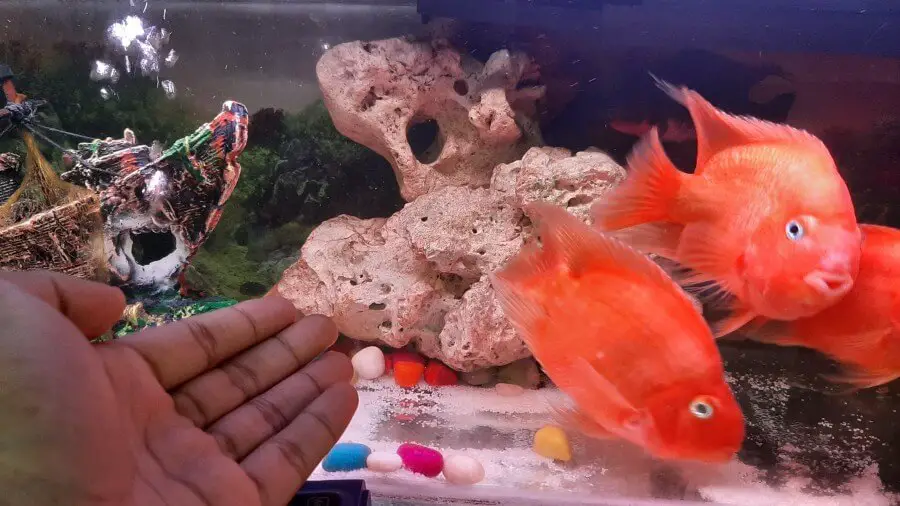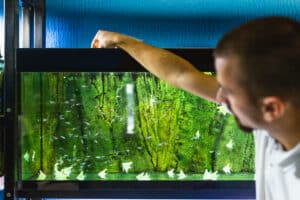If you love aquariums and you want to dress yours up a bit by adding rocks from a stream or even from your yard, don’t do this just yet. The truth is that not all rocks can be placed in an aquarium.
Some have too much calcium in them, and some can actually harm your fish. Because of this, you’ll have to test your rocks before you put them into your aquarium.
| Safe Rocks For Freshwater Aquarium | Safe Rocks For Saltwater Aquarium |
| Slate | Base Rock |
| Lava Rock | Fake Rock |
| Quartzite | Pukani Rock |
| Rainbow Rock | Live Rock |
Things To Consider With Aquarium Rocks

When you want to learn how to tell if a rock is safe for an aquarium, you have to consider two things. The first is the content of the rock because having too much calcium is unsafe for the pH level of the water. The second is the shape of the rock, which can cause harm to the fish if the rock is too sharp or pointy. Let’s take a look at both of these in more detail.
How To Test The Content Of The Rock
Rocks that you get from the yard or a stream can have too much calcium, algae, or other materials to use safely in your aquarium. To test them, here is what you need to do:
- Test for calcium carbonate. You can do this by pouring vinegar on the rocks. If it fizzes, never put them in your aquarium. You can also soak the rocks in water for one week, testing the pH level of the water daily. If the number continues to go up, don’t use these rocks.
- Test for hardness. To do this, place the rocks in water and check them daily for about a week. If they continue to get harder, don’t use them in your aquarium.
- Test for algae. If you found your rocks in a stream or other body of water, it’s very possible they could have algae, and those cannot go into your aquarium. Soak your rocks in water for four to five days, then check for green spots that indicate algae. Never use them if you see algae.
Even if your rocks have passed all of these tests, there are still certain rules for placing them in your aquarium the right way.
To start with, always wash the rocks thoroughly in sterilized water with a brush, then boil or bleach them to get all of the microbes off.
Dry them in the sun for one to two days, then re-soak the rocks in water for several days to make sure no algae develop. If none develop, rinse the rocks with warm water and gently place them in your aquarium.
Are Your Rocks Smooth?
In addition to making sure your rocks are not dangerous for the pH level of the water in your aquarium, you have to make sure no sharp or pointed edges are there to cause any injury or harm to the fish. Inspect the rocks carefully, and make sure not even a small pointed edge is on them.
Fish are small, and even a tiny pointed edge can hurt them. If your rocks are not completely smooth on all sides, don’t place them in your aquarium.
Good Rocks Vs. Bad Rocks
If you know your rocks, it’ll be easier to learn how to tell if a rock is safe for an aquarium. Some of the rocks you should never consider using in your aquarium include:
- Crushed corals
- Dolomite
- Geodes
- Limestone
- Marble
- Shells
Some of the rocks that are perfectly acceptable to place in your aquarium include:
- Granite
- Lava rock
- Onyx
- Quartz
- Sandstone
- Slate
Keep in mind that just because a rock looks harmless doesn’t mean it is good to use it in your aquarium. Rocks that you get from the outdoors are very likely to have a characteristic that means they’re useless for placing them in your aquarium, but you’ll want to test them to be sure anyway.
And if you’re curious about the best places to find good rocks for your aquarium, they include:
- Garden shops or nurseries
- Landscaping companies
- Pay-to-dig sites
- Pet stores
- Quarries
- Rivers
If you want to be sure, buying rocks from gardening centers or nurseries is your best bet. You can’t be too careful before placing any type of rocks into your aquarium, so make sure you test them before doing anything else to make sure that they’re safe for your aquarium and won’t harm any of your fish.
More Guidance About Choosing The Rocks For Aquarium
When you’re interested in placing rocks in your aquarium, does it matter whether the aquarium is saltwater or freshwater? As a matter of fact, it does. Because of the delicate balance involved in saltwater aquariums, it’s crucial that you only use rocks that you purchase from a nursery or pet store or even online.
Why? Because these rocks are usually cured, and cured rocks are what you need for a saltwater aquarium.
Some people only use fake rocks when they have a saltwater aquarium, but keep in mind that even the fake rocks that come in many different colors can have dye in them that are unsafe to use.
Your best bet is to check the literature that comes with your rocks and make sure they are safe to use in your saltwater aquarium. If you have any doubts whatsoever, it’s best not to place them in a saltwater aquarium but choose other rocks instead.
For saltwater aquariums, you are usually safe using base rock, which is usually sold dry and should be cured first; live rock, which contains bacteria that are actually good for the saltwater in your tank; or fake rock, which is usually made of either ceramic or a combination of aragonite sand and cement.
Remember to choose your rocks carefully and make sure you take your time researching them.
Conclusion
Not all rocks are safe for aquariums. Certain rocks should be avoided altogether, especially if you have a saltwater aquarium tank.
Always do some research on the rocks you choose, especially if you chose them out of your yard or a body of water. For some people, it’s easier to choose rocks purchased from a nursery or gardening center so you don’t have to do anything to them first.
Hi! I’m Praveen Ghoshal, the founder of eFishkeeping.com. Inspired by my Dad, I got interested in fishkeeping when I was a kid. Since then, I have been involved with this hobby. Currently, I have 3 fish tanks at our home, and I enjoy this hobby with my full family. Read more about me here.








